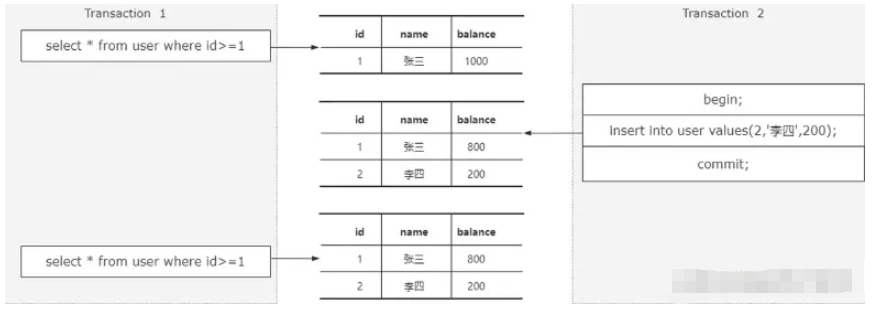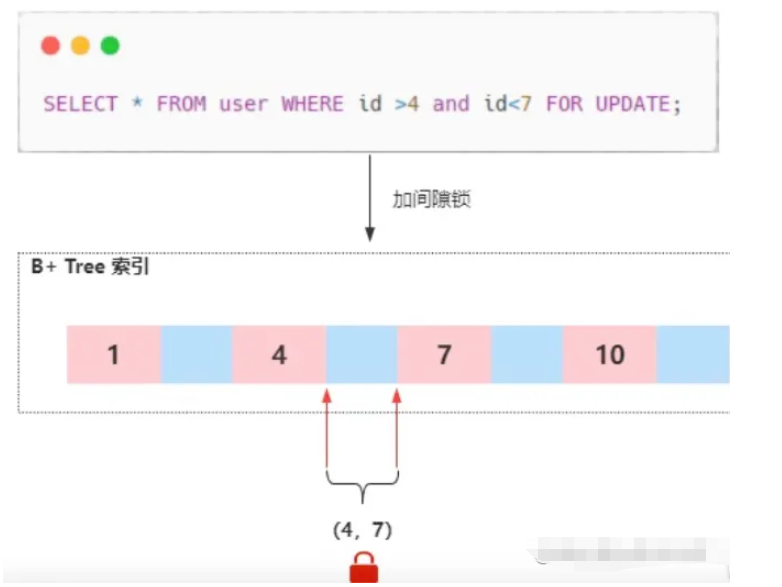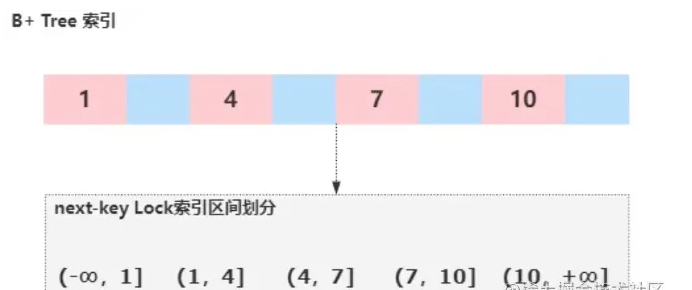How to solve phantom reading in innoDB in Mysql
1.Mysql transaction isolation level

#These four isolation levels, when there are multiple concurrent transaction conflicts, dirty reads and non-repeatable reads may occur , some problems of phantom reading, and innoDB solves a problem of phantom reading in the repeatable read isolation level mode,
2. What is phantom reading
phantom Reading means that in the same transaction, the results obtained when querying the same range twice are inconsistent.

As shown in the figure, in the first transaction, we execute a range query , at this time there is only one piece of data that meets the conditions, and in the second transaction, it inserts a row of data and submits it. Then when the first transaction queries again, the results obtained are more than the results of the first query. For a piece of data, please note that the first and second queries of the first transaction are both in the same thing. Therefore, phantom reading will bring data consistency issues
3. How does InnoDB solve phantom reading? The problem
InnoDB introduces gap lock and next-key lock mechanisms to solve the phantom read problem

Suppose there is such a B Tree index structure. This structure has 4 index elements, namely 1, 4, 7, 10. When we query a record through the primary key index, and pass for update## to this record #When locking

id=1this index



gap lock in innonDB. Its main function is to lock index records within a certain range

id > 4 and id When this range is locked, a gap lock will be added to the open interval range of (4, 7) in the B number, which means that in this In this case, other transactions that insert, update, or delete the data in this range will be locked, but there is another situation, such as this

id > 4 To lock under this condition, it needs to lock multiple index ranges, so in this case InnoDB introduces a mechanism called next-key lock, next-key lock is equivalent to the combination of gap lock and record lock. Record lock locks the row where the record exists. Gap lock locks the gap between the record rows, while next-key lock locks the two rows. The sum

next-key lock. When a transaction holds this When next-key lock is used for a row of data, a section of data in the left open and right closed range will be locked. Therefore, when locking through a range such as id > 4, InnoDB will add a next-key lock lock. The lock range is (4, 7] (7, 10] (10, ♾️]. The difference between Gap lock and next-key lock is in the locking range. Gap lock locks the gap between two indexes, while next-key lock will lock multiple index intervals, which includes record lock and gap lockWhen we use range query, it not only hits the Record record, but also includes the Gap gap When, in this case, the next-key lock is used, which is next-key lock It is the default row lock algorithm in Mysql
The above is the detailed content of How to solve phantom reading in innoDB in Mysql. For more information, please follow other related articles on the PHP Chinese website!

Hot AI Tools

Undresser.AI Undress
AI-powered app for creating realistic nude photos

AI Clothes Remover
Online AI tool for removing clothes from photos.

Undress AI Tool
Undress images for free

Clothoff.io
AI clothes remover

AI Hentai Generator
Generate AI Hentai for free.

Hot Article

Hot Tools

Notepad++7.3.1
Easy-to-use and free code editor

SublimeText3 Chinese version
Chinese version, very easy to use

Zend Studio 13.0.1
Powerful PHP integrated development environment

Dreamweaver CS6
Visual web development tools

SublimeText3 Mac version
God-level code editing software (SublimeText3)

Hot Topics
 1378
1378
 52
52
 MySQL: Simple Concepts for Easy Learning
Apr 10, 2025 am 09:29 AM
MySQL: Simple Concepts for Easy Learning
Apr 10, 2025 am 09:29 AM
MySQL is an open source relational database management system. 1) Create database and tables: Use the CREATEDATABASE and CREATETABLE commands. 2) Basic operations: INSERT, UPDATE, DELETE and SELECT. 3) Advanced operations: JOIN, subquery and transaction processing. 4) Debugging skills: Check syntax, data type and permissions. 5) Optimization suggestions: Use indexes, avoid SELECT* and use transactions.
 How to open phpmyadmin
Apr 10, 2025 pm 10:51 PM
How to open phpmyadmin
Apr 10, 2025 pm 10:51 PM
You can open phpMyAdmin through the following steps: 1. Log in to the website control panel; 2. Find and click the phpMyAdmin icon; 3. Enter MySQL credentials; 4. Click "Login".
 How to create navicat premium
Apr 09, 2025 am 07:09 AM
How to create navicat premium
Apr 09, 2025 am 07:09 AM
Create a database using Navicat Premium: Connect to the database server and enter the connection parameters. Right-click on the server and select Create Database. Enter the name of the new database and the specified character set and collation. Connect to the new database and create the table in the Object Browser. Right-click on the table and select Insert Data to insert the data.
 MySQL and SQL: Essential Skills for Developers
Apr 10, 2025 am 09:30 AM
MySQL and SQL: Essential Skills for Developers
Apr 10, 2025 am 09:30 AM
MySQL and SQL are essential skills for developers. 1.MySQL is an open source relational database management system, and SQL is the standard language used to manage and operate databases. 2.MySQL supports multiple storage engines through efficient data storage and retrieval functions, and SQL completes complex data operations through simple statements. 3. Examples of usage include basic queries and advanced queries, such as filtering and sorting by condition. 4. Common errors include syntax errors and performance issues, which can be optimized by checking SQL statements and using EXPLAIN commands. 5. Performance optimization techniques include using indexes, avoiding full table scanning, optimizing JOIN operations and improving code readability.
 How to create a new connection to mysql in navicat
Apr 09, 2025 am 07:21 AM
How to create a new connection to mysql in navicat
Apr 09, 2025 am 07:21 AM
You can create a new MySQL connection in Navicat by following the steps: Open the application and select New Connection (Ctrl N). Select "MySQL" as the connection type. Enter the hostname/IP address, port, username, and password. (Optional) Configure advanced options. Save the connection and enter the connection name.
 How to recover data after SQL deletes rows
Apr 09, 2025 pm 12:21 PM
How to recover data after SQL deletes rows
Apr 09, 2025 pm 12:21 PM
Recovering deleted rows directly from the database is usually impossible unless there is a backup or transaction rollback mechanism. Key point: Transaction rollback: Execute ROLLBACK before the transaction is committed to recover data. Backup: Regular backup of the database can be used to quickly restore data. Database snapshot: You can create a read-only copy of the database and restore the data after the data is deleted accidentally. Use DELETE statement with caution: Check the conditions carefully to avoid accidentally deleting data. Use the WHERE clause: explicitly specify the data to be deleted. Use the test environment: Test before performing a DELETE operation.
 How to use single threaded redis
Apr 10, 2025 pm 07:12 PM
How to use single threaded redis
Apr 10, 2025 pm 07:12 PM
Redis uses a single threaded architecture to provide high performance, simplicity, and consistency. It utilizes I/O multiplexing, event loops, non-blocking I/O, and shared memory to improve concurrency, but with limitations of concurrency limitations, single point of failure, and unsuitable for write-intensive workloads.
 MySQL: An Introduction to the World's Most Popular Database
Apr 12, 2025 am 12:18 AM
MySQL: An Introduction to the World's Most Popular Database
Apr 12, 2025 am 12:18 AM
MySQL is an open source relational database management system, mainly used to store and retrieve data quickly and reliably. Its working principle includes client requests, query resolution, execution of queries and return results. Examples of usage include creating tables, inserting and querying data, and advanced features such as JOIN operations. Common errors involve SQL syntax, data types, and permissions, and optimization suggestions include the use of indexes, optimized queries, and partitioning of tables.




